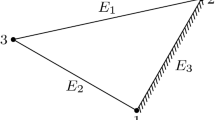Summary
This paper introduces and analyzes two ways of extracting the hydrostatic pressure when solving Stokes problem using thep version of the finite element method. When one uses a localH 1 projection, we show that optimal rates of convergence for the pressure approximation is achieved. When the pressure is not inH 1. or the value of the pressure is only needed at a few points, one may extract the pressure pointwise using e.g. a single layer potential recovery. Negative, zero, and higher norm estimates for the Stokes velocity are derived within the framework of thep version of the F.E.M.
Similar content being viewed by others
References
Adams, R.A. (1975): Sobolev Spaces. Academic Press, New York
Arnold, D., Scott, L.R., Vogelius, M. (1988): Regular inversion of the divergence operator with Dirichlet conditions on a polygon. Ann. Sc. Norm. Super Pisa, Cl. Sci., IV Ser.,15(2):169–192
Arnold, D.N., Babuška, I., Osborn, J. (1984): Finite element methods: Principles for their selection. Comput. Methods Appl. Mech. Engrg.45:57–96
Babuška, I. (1971): Error bounds for the finite element method. Numer. Math.16:322–333
Babuška, I., Suri, M. (1987): On the optimal convergence rate of thep-version of the finite element method. SIAM J. Numer. Anal.,24(4):750–776
Babuška, I., Szabó, B., Katz, I.N. (1981): Thep version of the finite element method. SIAM J. Numer. Anal., 18:515–545
Bernardi, C., Maday, Y., Métivet, B. (1987): Computation of the pressure in the spectral approximation of the Stokes problem. La Recherche Aérospatiale,1(1):1–21
Bernardi, C., Raugel, G. (1981): Méthodes d'éléments finis mixtes pour les équations de Stokes et de Navier-Stokes dans un polygone nonconvexe. Calcolo,18:255–291
Bramble, J.H., Schatz, A.H. (1977): Higher order local accuracy by averaging in the finite element method. Math. Comput.31(137):94–111
Brezzi, F. (1974): On the existence, uniqueness and approximation of saddlepoint problems arising from Lagrangian multipliers. RAIRO8:129–151
Ciarlet, P.G. (1978): The Finite Element Method for Elliptic Problems. North-Holland. Amsterdam
Costabel, M. (1988): Boundary integral operators on Lipschitz domains: Elementary results. SIAM J. Math. Anal.19:613–626
Dauge, M. (1988): Elliptic Boundary Value Problems on Corners Domains. Vol. 1341. Lecture Notes in Mathematics. Springer, Berlin Heidelberg New York
Dauge, M. (1989): Stationary Stokes and Navier-Stokes systems on two-or three-dimensional domains with corners, Part. I. Linearized equations. SIAM J. Math. Anal.20(1):74–97
Dorr, M. (1984): The approximation theory for thep-version of the finite element method. SIAM J. Numer. Anal.21(6):1180–1207
Girault, V., Raviart, P.-A. (1979): Finite Element Approximation of the Navier-Stokes Equations, Vol. 749. Lecture Notes in Mathematics. Springer, Berlin Heidelberg New York
Gottlieb, D., Orszag, S. (1977): Numerical Analysis of Spectral Methods: Theory and Applications, Vol. 26. CBMS-NSF Regional Conf. Series. Applied Math. SIAM, Philadelphia
Grisvard, P. (1985): Elliptic Problems in Nonsmooth Domains. Pitman, Boston
Hughes, T.J.R., Franca, L.P., Balestra, M. (1986): A new finite element formulation for computational fluid dynamics: V. Circumventing the Babuska-Brezzi condition: A stable Petrov-Galerkin formulation of the Stokes problem accomodating equal-order interpolation. Comput. Methods Appl. Mech. Eng.59:85–99
Douglas, J., Wang, J. (1989): An absolutely stability finite element method for the Stokes problem. Math. Comput.52(186):495–508
Jensen, S. (1991): AnH mo interpolation result. SIAM J. Math. Anal.22:785–791
Jensen, S., Vogelius, M. (1990): Divergence stability in connection with thep version of the finite element method. RAIRO, Modelisation Math. Anal. Numer.24(6):737–764
Johnson, C., Pitkäranta, J. (1982): Analysis of some mixed finite element methods related to reduced integration. Math. Comput.38(158):357–400
Kellogg, R.B., Osborn, J.E. (1976): A regularity result for the Stokes problem in a convex polygon. J. Funct. Anal.21(4):397–431
Lozi, R. (1978): Résultats numérique de régularité du problème de Stokes et du Laplacian itéré dans un polygone. RAIRO, Anal. Numér.12(3):267–282
Osborn, J. (1975): Regularity of solutions of the Stokes problem in a polygonal domain. In: B. Hubbard (ed.), Symposium on Numerical Solutions of Partial Differential Equations III. Academic Press, New York, pp. 393–411
Papadakis, P. (1988): Computational aspects of the determination of the stress intensity factors for two-dimensional elasticity. PhD thesis, Univ. of Maryland
Rønquist, E.M. (1988): Optimal spectrum element method for unsteady three-dimensional incompressible Navier-Stokes equations. PhD thesis, MIT
Scott, L.R., Vogelius, M. (1985): Conforming finite element methods for incompressible and nearly incompressible continua. In: Lectures in Applied Mathematics, Vol. 22, pp. 221 244, AMS
Scott, L.R., Vogelius, M. (1985): Norm estimates for a maximal right inverse of the divergence operator in spaces of piecewise polynomials. RAIRO, Modelisation Math. Anal. Numer.19(1):111–143
Seif, J.B. (1973): On the Green's function for the biharmonic equation in an infinite wedge. Trans. Amer. Math. Soc.182:241–260
Suri, M. (1990): On the stability and convergence of higher order mixed finite element methods for second order elliptic problems. Math. Comput.54(189):1–19
Suri, M. (1990): Thep-version of the finite element method for elliptic problems of order 2l. RAIRO, Modelisation Math. Anal. Numer.24:265–304
Szabó, B., Babuška, I., Chayapathy, B.K. (1989): Stress computations for nearly incompressible materials by thep-version of the finite element method. Int. J. Numer. Methods Eng.28(9):2175–2190
Szabó, B.A. (1985): PROBE: Theoretical Manual. Noetic Technologies Corp., St. Louis, Missouri
Temam, R. (1977): Navier-Stokes equations. North-Holland, Amsterdam
Vogelius, M. (1983): A right-inverse for the divergence operator in spaces of piecewise polynomials Application to thep version of the finite element method. Numer. Math.41:19–37
Author information
Authors and Affiliations
Additional information
Partially supported by ONR grants N00014-87-K-0427 and N00014-90-J-1238
Rights and permissions
About this article
Cite this article
Jensen, S. On computing the pressure by thep version of the finite element method for Stokes problem. Numer. Math. 59, 581–601 (1991). https://doi.org/10.1007/BF01385797
Received:
Revised:
Issue Date:
DOI: https://doi.org/10.1007/BF01385797



